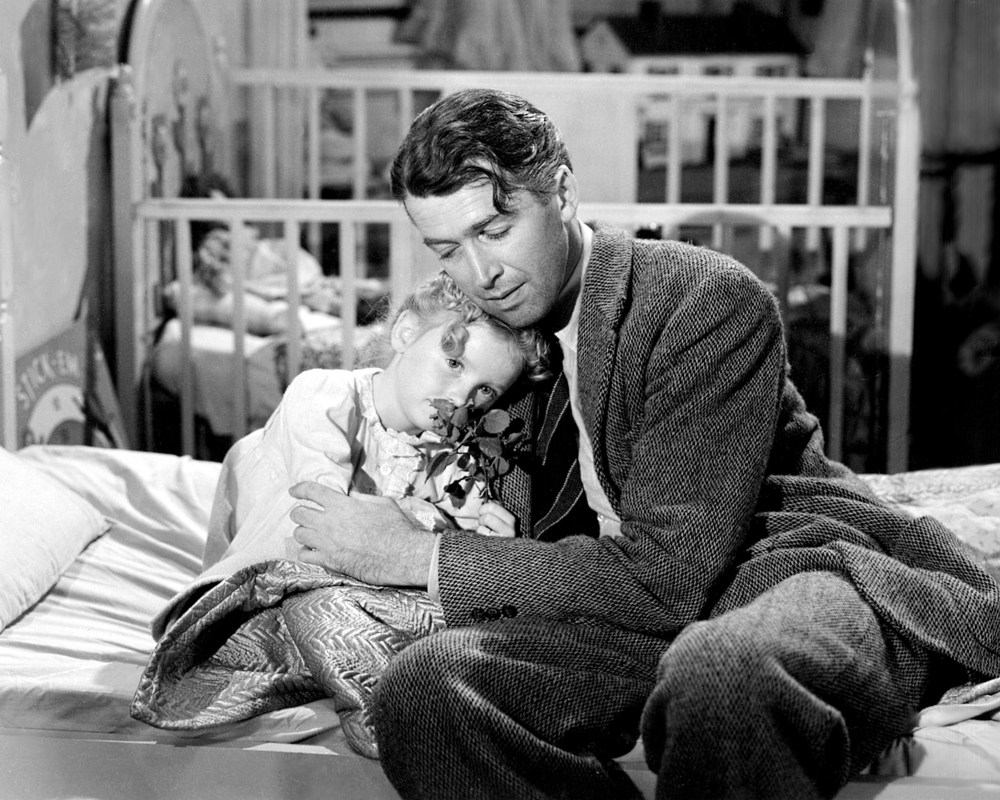Is “It’s a Wonderful Life” really so wonderful?
Ever since the 1946 film was rediscovered in the late ’70s, it’s become a holiday tradition, as predictably comforting as the season’s first cup of cocoa. Broadcast on network TV, featured in big-screen revivals, it’s so ever-present it’s almost impossible not to watch it.
But have you ever really seen it?
We all think we know “It’s a Wonderful Life” – Zuzu’s petals and Clarence’s wings, the bridge in the snowstorm and “Buffalo Gals” on the Victrola. But we rarely wonder about what people put into making it — or what it cost them in the end.
Nor do we think about its less wondrous – or, at least, more worried — side. How it frets about class, prejudice, and middle-aged male angst. How it pokes into darker places than most Hollywood pictures – let alone holiday movies – ever dare.
The project began in 1946, with director Frank Capra and star Jimmy Stewart fresh from their service in World War II. Capra had spent the time shooting the documentary series “Why We Fight,” a paean to democracy. Stewart had flown white-knuckled bombing missions over Germany.
Neither man emerged unchanged, but both were now at opposite points in their lives.
Capra was at his peak – a string of Hollywood successes behind him, and the limitless promise of his own company, Liberty Films, just ahead. Stewart, meanwhile, was at a crossroads, filled with uncharacteristic self-doubt about his career and his life.
Stewart carried those worries onto the set. He never warmed to co-star Donna Reed. His growing dissatisfaction with the whole idea of acting was so obvious Lionel Barrymore even took him aside for a pep talk about the nobility of the thespian’s life. But Stewart’s mood lingered – and helped make George Bailey who he was.
Capra, meanwhile, brought his cocky confidence. The shooting schedule stretched over a leisurely three months, while costs ballooned to $3.2 million – an extravagant amount for a 130-minute, black-and-white film. (Just seven years before, the 238-minute, Technicolor “Gone With the Wind” had cost only $3.8 million — and burnt down Atlanta in the bargain.)
Economically, it was reckless. Artistically, it gave the film the care and attention to detail it needed.
As a director, Capra created gorgeous shots. Some – like the way the frosted-glass window in the drugstore frames Mr. Gower’s drinking – evoked old, silent-film artistry. Others, like the ground-breaking freeze-frame introduction to George Bailey, pointed toward a new Hollywood style. Every sequence – the high-school dance, the run on the bank, the honeymoon — was both perfect in itself and led to the next.
And although Stewart fell back on his old aw-shucks act in early scenes – he had to do something to pass his 39-year-old self as a small-town boy dreaming of college – as the film grows darker, he goes deeper, screaming at his uncle and abusing his family. “Why did we have to have all these kids?” he snarls at his wife – an astonishing line for a Hollywood dad, and the first sign of the new, gritty, “adult” Stewart who would eventually reappear in “Winchester ’73,” “Rear Window” and “Vertigo.”
There are a few other startling things sneaked into this film, and past the censors. Like the shot of Gloria Grahame sashaying up the street, kindling lust in the middle-aged men who watch her. “Gotta go home, see what the wife’s doin’” a suddenly amorous cop announces, abruptly heading out. “Family man!” the cabbie mockingly observes.
And then there are the movie’s politics. Capra’s own were complicated – a conservative Republican, he instinctively distrusted the rich, a lover of “the common man,” he always feared the mob.
In “It’s a Wonderful Life,” though, his position on the class struggle is clear. Potter, the movie’s villain, is a banker, a mean monopolist who owns just about everything (including the police) and sneers at the “lazy, discontented rabble” whom Bailey helps at the communal Building and Loan. (The Sicilian-born Capra makes Potter an anti-immigrant bigot, too, sneering at the town’s Italian-Americans as “a bunch of garlic-eaters.”)
But even a little wealth corrupts in Bedford Falls. Sam Wainwright is the town’s smiling success story, a generous back-slapper who sees the promise of plastics decades before “The Graduate” (and later makes a fortune in the war). But he’s also flashy and rude and Mary speedily dumps him in favor of the altruistic George — a soul so pure he doesn’t think about profit and “never made a dime” off all the working-class housing he builds.
It’s a startlingly progressive picture – and it had the bad luck to be released just as Washington was beginning their attack on Hollywood “Reds.” Ayn Rand, busy lecturing the studios on liberal bias, even cited it as a prime example of pinko propaganda. (She’s probably the redacted source quoted in a contemporary FBI memo, saying you can see the use of a typical “Communist trick” in the way the movie “deliberately maligned the upper class, attempting to show the people who had money were mean and despicable.”)
Even without the political attacks, the finished film soon ran into trouble. It’s a myth that it was a total disaster; “It’s a Wonderful Life” got some good reviews and an Academy Award nomination for Best Picture. (Among the year’s top moneymakers, it placed #26th.) But Capra had so drastically blown the budget, only a genuine blockbuster could have ever turned a profit. Its financial failure helped cut short his career.
And yet, ironically, helped make the legend of “It’s a Wonderful Life.”
A corporate orphan when Liberty Films folded, the film eventually slipped into the public domain. It became a local-TV mainstay and, after the home-video revolution of the ’80s, a VHS bargain. Suddenly, millions of people rediscovered the movie, and its view of small-town American life. It became a sentimental favorite – then a figure of fun, with cynics jibing that, personally, they’d prefer to live in Pottersville.
But look at Bedford Falls again, and ask yourself – how innocent is it, really?
What is that trouble that Graham’s Violet Bick has gotten into – and what’s waiting for her when she returns home? How powerful is Potter, and how much more powerful will he become? (Forgotten – even by the censors – is the fact that he’s never caught or punished for stealing the Baileys’ bankroll.)
Yes, the tearful ending has the working people of Bedford Falls rallying around George, making up that $8,000 with jukebox change and crumpled dollar bills. But does this happy ending make up for everything else George has lost? His beloved father dead from stress and over-work? His own dreams delayed, down-sized and finally dismissed?
A wonderful life? That’s what Clarence assures George he has. But the real answer for him, as it is for most of us, is more complicated. And so is the wonderful movie that we so often watch, and rarely truly see.
This article appeared in an InsideHook newsletter. Sign up for free to get more on travel, wellness, style, drinking, and culture.
























